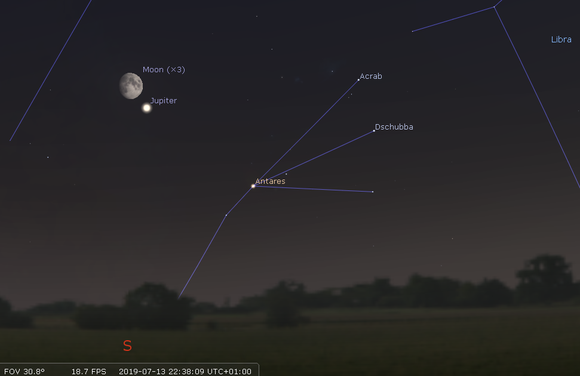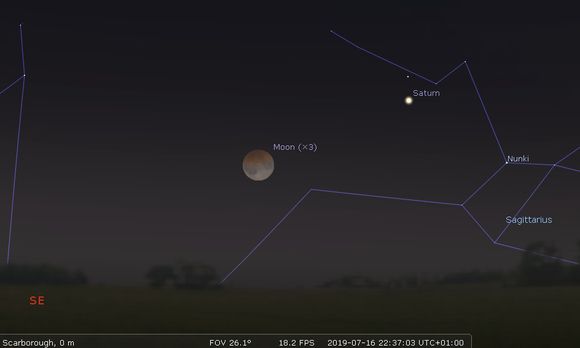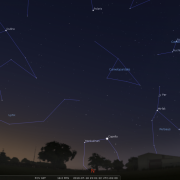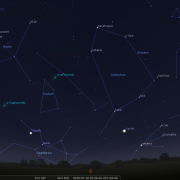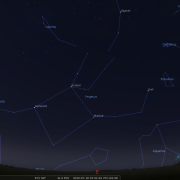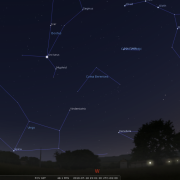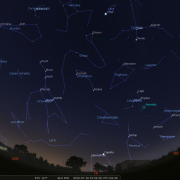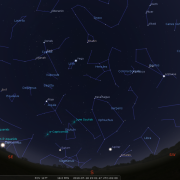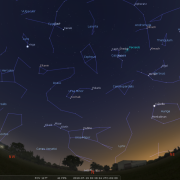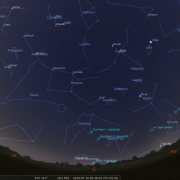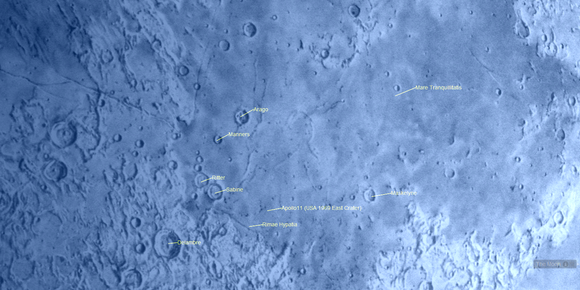Welcome to the WDAS monthly newsletter for July 2019: a digest of the month's latest contributions to our website. Below you'll find Society News; past and coming events; Mark celebrates the 50th anniversary of the first Moon landing; and, of course, Sky Notes including details of the partial lunar eclipse with Saturn watching on.
Society News
Unsurprisingly, our star party events in June all fell victim to the poor weather conditions, either cloud or rain ...or both. It’s a quite a few years since we last endured a soggy June, but it was bound to happen sooner or later. Let’s be philosophical; better June than late July, August or September, when we need fine evenings. Hope things buck up during July.
Sky Notes
In this month's Sky Notes:
Planetary Skylights
 Earth reaches aphelion (furthest from Sun) on July 4th, when it lies at a distance of 95 million miles or 152 million km.
Earth reaches aphelion (furthest from Sun) on July 4th, when it lies at a distance of 95 million miles or 152 million km.

Two planets dominate the July night sky- and they happen to be the two largest planets in the solar system; Jupiter and Saturn. Having reached opposition last month, Jupiter is visible as soon as skies become dark enough and at mag -2.6 is by far the brightest point in the sky. Look for it across in the SE as dusk falls not too far above the horizon. Jupiter currently resides in the southern most reaches of Ophuichus, which crosses the ecliptic and as such is going to be visible low in British summer skies. Observations require patience, but when seeing is steady, the view through the eyepiece is worth the wait with plenty of interest to follow.
Residing on the south equatorial belt is the huge ‘storm like’ feature known as the great red spot, a feature which in the last few decades has shrunk by almost a third, but still dwarf’s Earth in size. Because of the rapid rotation of Jupiter (10hrs approx) it is not always on view, (see times and dates). When facing Earth, the GRS resembles a subtle pale oval.
The most dynamic aspect of the Jovian system, the four Galilean moons, certainly warrants attention, with an ever changing configuration noticeable even over the course of a few hours.
On July 26th Jupiter resides close by the deep sky object NGC 6235, a magnitude 9 globular cluster some 37,000 light years distant, whilst Jupiter and its moons will be just 424 million miles (682 million km) away. The two objects will fit within the same eyepiece field, a fascinating view, given the huge distance gap between them.
Galilean moon shadow transits
Io on the following dates:
- 6th: 22:00h–midnight
- 14th: midnight–02:00h
- 22nd: from 22:00h
- 29th: 22:15h–midnight.
Europa:
- 2nd: 22:00h–23:30h
- 8th: midnight–02:00h.
Ganymede:
- 10th 22:00h–midnight
- 17th: 22:00h to post midnight
- 18th: 01:00h.
The Great Red Spot is visible on Jupiter’s disk on the following dates:
- 1st: 23:00h–02:00h
- 4th: 01:00h onwards
- 5th: 22:30h onwards
- 7th: 22:00h–01:00h
- 8th: 22:00h–02:00h
- 10th: 22:00h–midnight
- 12th: 22:00h–midnight
- 17th: 22:00h–midnight
- 19th: from 22:00h
- 21st: midnight
- 22nd: from 22:00h
- 24th: from 21:30h
- 26th: from 23:00h
- 27th: until 22:00h
- 29th: 21:00–23:00h
- 31st: 21:00h until midnight.
 The Moon lies nearby Jupiter in the sky on the 13th
The Moon lies nearby Jupiter in the sky on the 13th
 Saturn reaches opposition on the 9th and is therefore visible throughout the short hours of semi darkness experienced during the early summer months. Following in Jupiter’s wake by a few hours, Saturn will be on show low in the SE by 22:30h by the start of July, arcing low across the south over the course of the night. After Jupiter, Saturn is the next brightest planet currently visible at mag +0.1 and so is quite prominent.
Saturn reaches opposition on the 9th and is therefore visible throughout the short hours of semi darkness experienced during the early summer months. Following in Jupiter’s wake by a few hours, Saturn will be on show low in the SE by 22:30h by the start of July, arcing low across the south over the course of the night. After Jupiter, Saturn is the next brightest planet currently visible at mag +0.1 and so is quite prominent.
Residing in Sagittarius, just behind the ‘teapot’ asterism, Saturn suffers from the same disadvantages as Jupiter, ie. low altitude and unsteady seeing. Observations are therefore going to be somewhat compromised, but during moments of clarity Saturn is still a wonderful sight. The rings are still well orientated, with the two main ones; ring A and ring B, separated by the Cassini division. The dark inner ring (C) will be more difficult to make out, especially with Saturn being located low down.
If you have a pair of larger binoculars, or any telescope, look for Saturn’s largest moon; Titan, visible as a speck of light nearby. On July 3rd and 19th, Titan lies to the east of Saturn, and to the West it on 11th and 27th. Our Moon lies in proximity to Saturn in the sky on the 15th.
16-Jul-2019 at 23:30h (Looking South-East): Saturn and The Moon in Partial Eclipse.
(Click for full-sized image.)
Partial Lunar Eclipse
We have another lunar eclipse to look forward to in July (let’s hope we have better luck than the lunar eclipse last July – when in it rained down fire and brimstone during the evening)
The forthcoming eclipse on the 16th /17th is a partial umbral eclipse and will be already underway as the moon rises. The initial stages of the eclipse, first and second contacts, take place before the moon actually rises, when the moon moves into Earth’s penumbral shadow, becoming totally immersed in this lighter shadow. Things get interesting as the moon slides into the deeper umbral shadow shortly after 21:00h, with the moon rising around 21:30h already in this phase.
Mid eclipse occurs around 22:30h, by which time approximately 56% of the moon will be in umbral shadow. Forth contact arrives at midnight, when the moon leaves the umbral shadow and finally the penumbral phase ends at 01:20h when the whole eclipse is over. Although not total, it should nevertheless be an interesting eclipse, and will no doubt attract considerable public attention if the weather plays ball. We shall be holding a lunar eclipse party on the evening from the usual location of the Cook headland setting up shortly after 21:00h.
Meteors

A number of lesser meteor showers occur during July. The Capri-Cornids have 3 maxima, July 8, 15, and 26, all with zenith hourly rates (ZHR) of less than 10, barely more than sporadic rates. Moon light will washout the middle date, but not interfere with the other dates. Early morning hours will offer the best chance of catching a few shooting stars.
The Alpha Cygnids peak on July 21st, but again rates are barely more than sporadic levels. Cygnus is well placed high in the SSE by midnight. Moon light will interfere until after midnight.
The Delta-Aquarids are a little more prolific, peaking on July 30th with a ZHR of around 15. As always post-midnight observations will offer the best chance spotting any meteors.
July 2019 Sky Charts
|
Looking North
Mid-July - 23:00h |
Looking South |
|
Looking East
Mid-July - 23:00h |
Looking West
Mid-July - 23:00h |
|
Northern Aspect
Mid-July - 23:00h |
Southern Aspect
Mid-July - 23:00h |
| Looking North (Early) Mid-July - 03:30h |
Looking South (Early) Mid-July - 03:30h |
Additional Image Credits:
- Planets and Comets where not otherwise mentioned: NASA
- Sky Charts: Stellarium Software
In-Focus
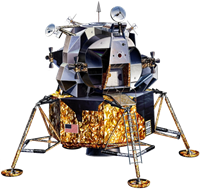 July sees the 50th anniversary of the first moon landing, quite an alarming fact for many over a certain age, whilst for many more it is just a milestone event in the annals of the history books, which barely relates today.
July sees the 50th anniversary of the first moon landing, quite an alarming fact for many over a certain age, whilst for many more it is just a milestone event in the annals of the history books, which barely relates today.
For those who can remember, we watched in awe when Apollo 11 blasted off from Cape Canaveral on July 16th 1969. Four days later the world held its collective breath as the lunar lander 'Eagle' touched down on the Sea of Tranquillity with just a few seconds of fuel left to burn.
It was the culmination of millions of hours of experiments, development and testing, the origin of which could be traced back even before the menace of the V2. Indeed, without the assistance of Werner Von Braun, chief designer of the German WW2 rocket, the US manned space program would hardly have made it off the ground. After President Kennedy tasked NASA, ‘within the decade’, to land a man on the Moon and safely return them, it was Braun’s design of the mighty 110 metres tall Saturn V rocket, which would allow man to break free the shackles of Earth’s gravity and propel them to the Moon and back.
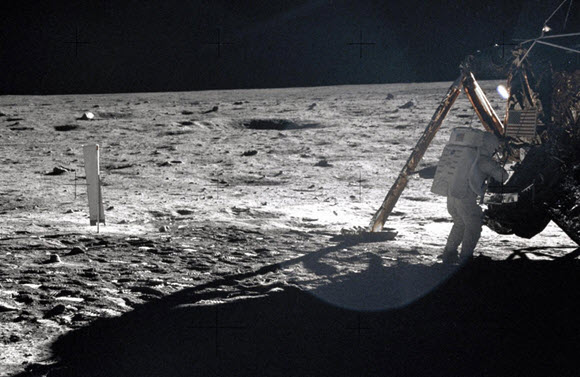
Fifty years on I can still vaguely remember those momentous events in July ‘69. I was six years old and as a special treat allowed to stay up and watch ‘Eagle’ land on the moon’s surface. Much to my annoyance however, the first tentative steps were not taken for another six hours, very early morning UK time, when i was asleep. Oblivious to this on July 21st, Neil Armstrong opened the hatch, descended down the ladder and took that 'one small step, one giant leap for mankind’, ushering in a new dawn of manned space exploration and lunar bases, or so many assumed at the time.
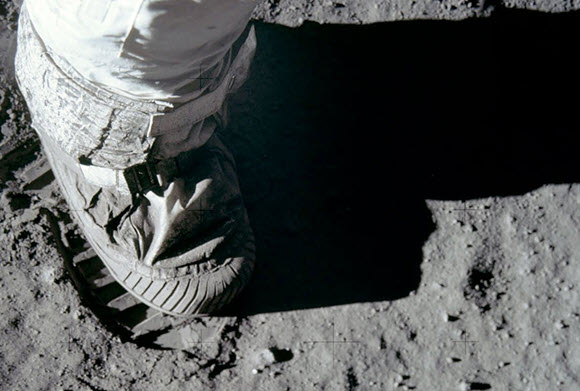
Only 36 humans have ever gazed down at the Moon’s surface from lunar orbit, and a mere dozen mortals having set foot on it. Only now do we fully appreciate just how brave and courageous those men with the ‘right stuff’ were.

As for the Apollo, well after just three years the program was terminated, a casualty of a more austere political and economic climate. Following the drama of Apollo 13, (which i vividly remember) even the public appeared to lose interest and crucially the media. Back in the late 60’s, anything seemed possible, routine space travel, lunar bases, the colonisation of other worlds; it was regarded as been achievable within three decades. Half a century later in a world far more technologically advanced, such grandiose schemes remain unfulfilled dreams.
Let’s face fact’s, manned exploration of space is difficult, dangerous and expensive. Without political desire or global economic co-operation, the human conquest of space will continue to take faltering steps. To put things in perspective, no human has ventured more than 250 miles from Earth since 1972. That’s the distance from Whitby to London!
This rather deflating situation finally looks about to change, and before the end of the next decade i feel confident that humans will not only have returned to the moon on a more permanent footing, but may also have set foot on Mars. It might be NASA, the Chinese, Elon Musk, Jeff Bezos, Richard Branson or even a combination of any of the above. J.F Kennedy once famously proclaimed; ‘We choose to do these things, not because they are easy, but because they are hard'. They were, but we triumphed and have no doubt will do so again in the coming years. Ultimately it is in our own interests to make science fiction, science fact.
Events
 Observe the night sky with us at the Bruce Observatory, Whitby School
Observe the night sky with us at the Bruce Observatory, Whitby School
Observing Nights are held weather permitting: check for a relatively clear sky before leaving home. If in doubt, Mark can be reached on 07886069339
Please note the college drive gate is now operated via a electronic key code - so anyone wishing to attend must be at the car park at the top of the drive by 19:00hrs - unless an arrival time has been arranged with Mark/Keith.
 Whitby School - Room H1.
Whitby School - Room H1.
In Members' monthly meetings we usually take a tour of the night sky for the coming month using the Planetarium program. Have talks and presentations on various topics of astronomy/space etc, and discuss future events etc. New members welcome.

